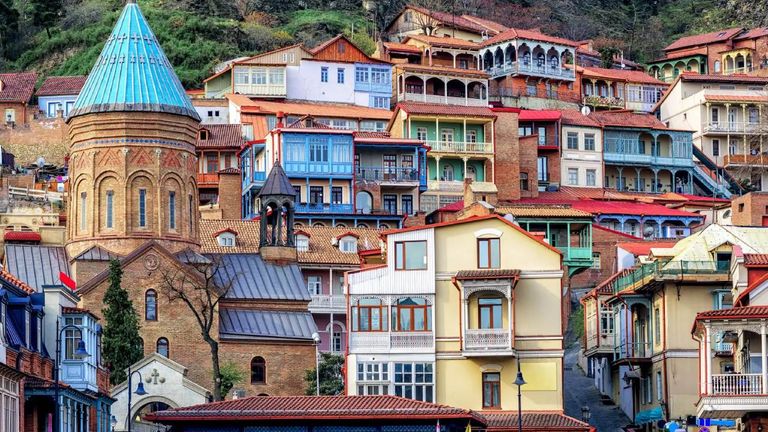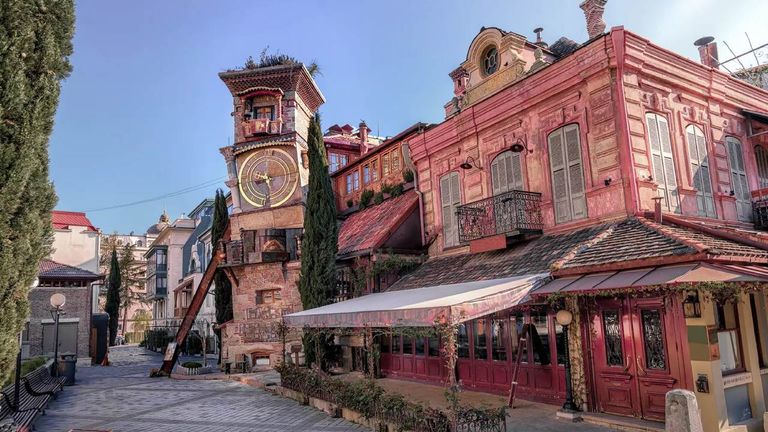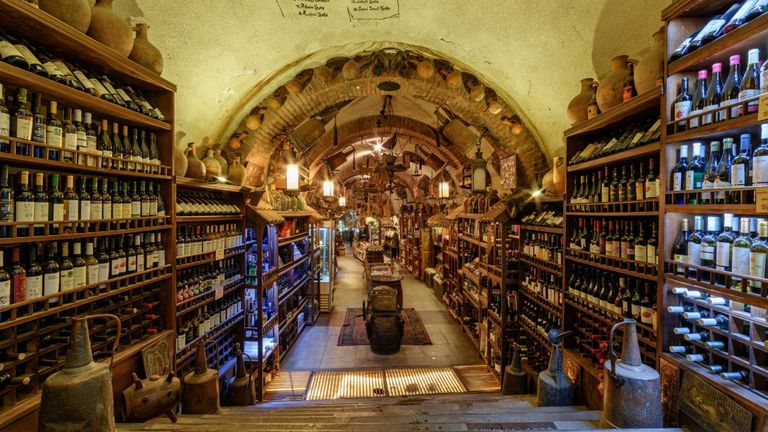I stood in silence, watching the Sunday liturgy unfold at the Holy Trinity Cathedral in Tbilisi, the capital city of Georgia. In the middle of the church, a group of clergy members read passages while people of the congregation lit thin beeswax candles, each passing the flame to the person next to them to create a long glimmering chain of illumination.
This was my first time attending a religious service in Georgia, and while I had known to cover my head with a scarf before entering, I had missed the memo about needing a candle. A woman next to me noticed my empty hands and graciously passed me a spare before sharing her flame with me — immediately making me feel welcome in the unfamiliar space.
Although I couldn’t see a choir anywhere, I could hear the melodic sounds of Georgian polyphonic singing echoing through the cathedral. Getting the chance to hear this intangible heritage tradition was among the main reasons I had come to the church that morning, and I was excited to spend the rest of my time in Tbilisi learning all I could about the traditions that have shaped this ancient country.
 Tbilisi's Old Town is compact and makes a good homebase for visitors.
Tbilisi's Old Town is compact and makes a good homebase for visitors.
Credit: 2025 Georgian National Tourism AdministrationA Stroll through the Past
Like many visitors to Tbilisi, I based myself in the compact, pedestrian-friendly Old Town. I started my visit at Tbilisi History Museum, perusing its impressive collection of models of traditional houses and collection of ancient artifacts. The museum is located on the grounds of Old Tbilisi’s historic Caravanserai, a traditional inn and trading center for travelers on the Silk Road.
In the cavernous basement of the same building is Tbilisi Wine Museum, which chronicles the country’s 8,000-year history of winemaking (Georgia is believed to be the world’s oldest wine producer). Highlights include traditional viticultural tools and archaeological finds, including qvevri — massive turnip-shaped, terra-cotta vessels that Georgia's winemakers have been using to store and ferment wine for generations.
 Though set in Old Town, this clock tower was built in 2010 by a local artist and is a popular attraction.
Though set in Old Town, this clock tower was built in 2010 by a local artist and is a popular attraction.
Credit: 2025 Georgian National Tourism AdministrationNext door to the museums sits Sioni Cathedral of the Dormition, a temple dating to the sixth century (though the current structure was built in the Middle Ages). Stop inside to see its grapevine cross relic, a symbol of Georgian Christianity that was fashioned from vines by Saint Nino, a woman who preached Christianity in the region.
From here, it’s a vigorous uphill trek (or a short walk plus a funicular ride) to the Mtatsminda Pantheon. This mountainside cemetery is where many of the country's most celebrated actors, writers and poets are buried, and it offers beautiful views of the Tbilisi cityscape.
 A wine cellar at Meidan Bazaar in Old Town
A wine cellar at Meidan Bazaar in Old Town
Credit: 2025 efired/stock.adobe.comWhere to Wine, Dine and Shop
Tbilisi’s Old Town has loads of wine bars where visitors can sample Georgia’s famous “orange” wine (which is more often referred to as “amber” wine on menus), along with plenty of reds and whites. I particularly enjoyed Nino Meris Wine Selection, a cozy women-owned spot where clients can sample red, white and amber wines by the glass or by the flight. Pair sips with a side of Georgian churchkhela, a semisweet chewy snack made of nuts, flour and grape juice.
For a traditional Georgian meal, head up Rustaveli Avenue to Tanini Restaurant. Must-tries include khinkali — pillowy dumplings stuffed with meat or potatoes — and my personal favorite, pkhali, a spread made of crushed walnuts and vegetables such as spinach or eggplant and topped with pomegranate seeds.
Those in the market for souvenirs should visit the centuries-old Meidan Bazar, a subterranean craft market flanked with vendors selling everything from ajika (a traditional pepper-based spice blend) to big fluffy hats — and of course plenty of wine. The market extends for a few blocks; exiting through the southern end will put clients steps away from Abanotubani, Old Town’s hot springs district.
The Hot Springs of Tbilisi
Tbilisi’s sulfur-rich hot springs — believed to have curative properties — are what led King Vakhtang Gorgasali to establish the city nearly 1,600 years ago. It was also one of the main things that drew me to Tbilisi in the first place, so I was delighted to try out two different bathhouses during my stay, both of which only offered private rooms. On the first evening, I soaked at Gulo’s Thermal Spa, a historic complex with atmospheric domed bathing areas and reasonable prices. On my final night, I splurged for Chreli Abano, a swankier option and a good choice for group tours — the largest rooms accommodate 12 guests.
 The Chronicles of Georgia monument
The Chronicles of Georgia monument
Credit: Margot BiggBeyond Old Town
While it’s easy to stick to Old Town Tbilisi, it’s worth sending clients beyond its cobbled lanes. One must-see is the Chronicles of Georgia, a massive monument consisting of 110-foot-tall pillars that tell the story of the country through massive relief sculptures. Construction began in 1985, but it was never quite completed due to funding losses following the collapse of the Soviet Union.
Travelers interested in history will love visiting Mtskheta, about a half-hour drive from the capital. It was in this ancient city that King Mirian III converted from paganism in the fourth century; as such, it’s considered the birthplace of Christianity in Georgia. Highlights of this UNESCO World Heritage city include the hilltop Jvari Monastery and Svetitskhoveli cathedral, believed to house one of Jesus’ robes. Although history is a big draw, the cathedral interiors — full of beautifully preserved frescoes and gilded icons — are a dream for art lovers.
If your clients are oenophiles — as many visitors to Georgia are — send them on a day tour to the Kakheti wine region, where the majority of the country’s grapes are grown. It's the place to learn about Georgia's viticultural traditions — plus, it’s pretty fun to sample wines right where they’ve been produced for millennia.